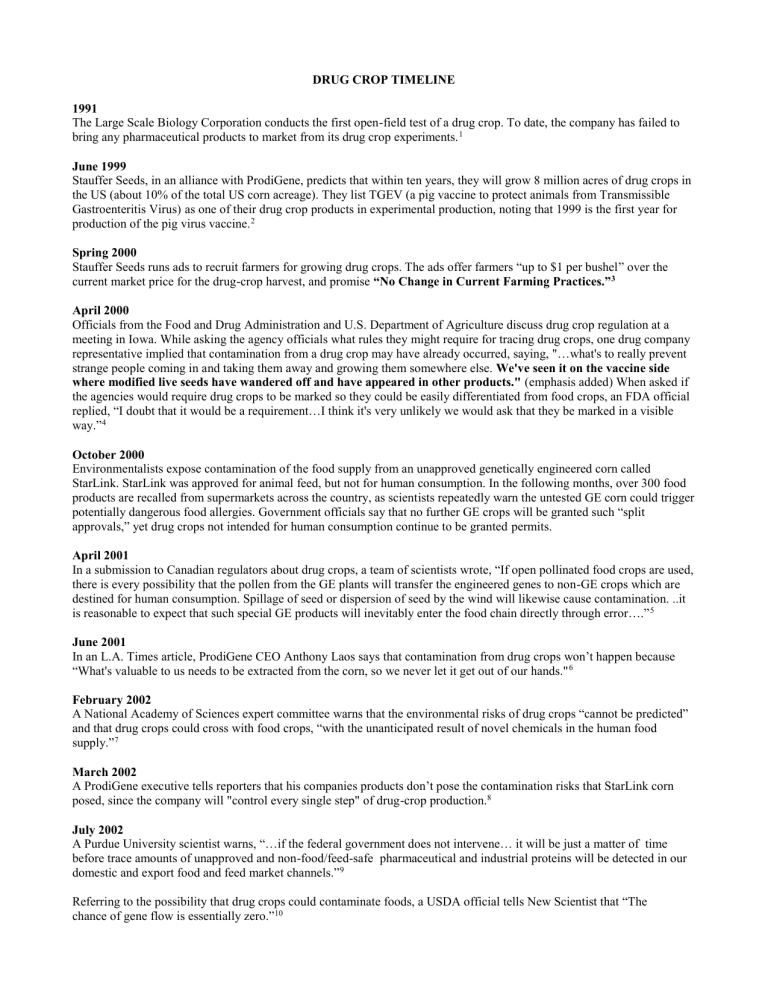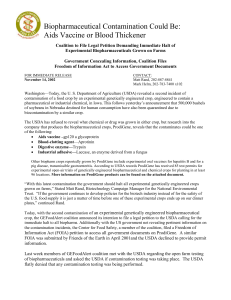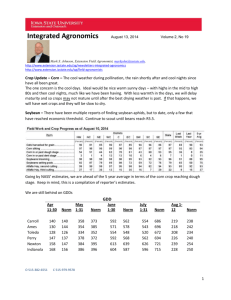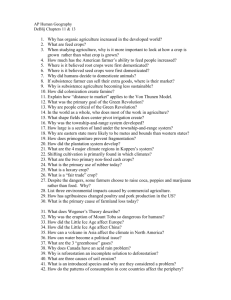Regulation of Genetically Modified Food: A Submission to the

DRUG CROP TIMELINE
1991
The Large Scale Biology Corporation conducts the first open-field test of a drug crop. To date, the company has failed to bring any pharmaceutical products to market from its drug crop experiments.
1
June 1999
Stauffer Seeds, in an alliance with ProdiGene, predicts that within ten years, they will grow 8 million acres of drug crops in the US (about 10% of the total US corn acreage). They list TGEV (a pig vaccine to protect animals from Transmissible
Gastroenteritis Virus) as one of their drug crop products in experimental production, noting that 1999 is the first year for production of the pig virus vaccine.
2
Spring 2000
Stauffer Seeds runs ads to recruit farmers for growing drug crops. The ads offer farmers “up to $1 per bushel” over the current market price for the drug-crop harvest, and promise “No Change in Current Farming Practices.” 3
April 2000
Officials from the Food and Drug Administration and U.S. Department of Agriculture discuss drug crop regulation at a meeting in Iowa. While asking the agency officials what rules they might require for tracing drug crops, one drug company representative implied that contamination from a drug crop may have already occurred, saying, "…what's to really prevent strange people coming in and taking them away and growing them somewhere else. We've seen it on the vaccine side where modified live seeds have wandered off and have appeared in other products." (emphasis added) When asked if the agencies would require drug crops to be marked so they could be easily differentiated from food crops, an FDA official replied, “I doubt that it would be a requirement…I think it's very unlikely we would ask that they be marked in a visible way.” 4
October 2000
Environmentalists expose contamination of the food supply from an unapproved genetically engineered corn called
StarLink. StarLink was approved for animal feed, but not for human consumption. In the following months, over 300 food products are recalled from supermarkets across the country, as scientists repeatedly warn the untested GE corn could trigger potentially dangerous food allergies. Government officials say that no further GE crops will be granted such “split approvals,” yet drug crops not intended for human consumption continue to be granted permits.
April 2001
In a submission to Canadian regulators about drug crops, a team of scientists wrote, “If open pollinated food crops are used, there is every possibility that the pollen from the GE plants will transfer the engineered genes to non-GE crops which are destined for human consumption. Spillage of seed or dispersion of seed by the wind will likewise cause contamination. ..it is reasonable to expect that such special GE products will inevitably enter the food chain directly through error….” 5
June 2001
In an L.A. Times article, ProdiGene CEO Anthony Laos says that contamination from drug crops won’t happen because
“What's valuable to us needs to be extracted from the corn, so we never let it get out of our hands." 6
February 2002
A National Academy of Sciences expert committee warns that the environmental risks of drug crops “cannot be predicted” and that drug crops could cross with food crops, “with the unanticipated result of novel chemicals in the human food supply.” 7
March 2002
A ProdiGene executive tells reporters that his companies products don’t pose the contamination risks that StarLink corn posed, since the company will "control every single step" of drug-crop production.
8
July 2002
A Purdue University scientist warns, “…if the federal government does not intervene… it will be just a matter of time before trace amounts of unapproved and non-food/feed-safe pharmaceutical and industrial proteins will be detected in our domestic and export food and feed market channels.” 9
Referring to the possibility that drug crops could contaminate foods, a USDA official tells New Scientist that “The chance of gene flow is essentially zero.” 10
August 2002
A representative of the Biotechnology Industry Organization (BIO), the genetic engineering companies’ trade group, says that linking the StarLink contamination case to the possibility for drug-crop contamination is unfair, since drug crops “are not really crops, they are laboratory facilities." 11
September 2002
USDA discovers a ProdiGene plot of pig-drug corn growing near ordinary cornfields in Iowa. Concerned that gene flow from the drug corn could have contaminated neighboring fields, the agency orders 155 acres of corn pulled up and incinerated. Though there is no way to know if this boundary adequately addressed all possible contamination, the government agency keeps the incident secret for two months.
FDA releases a draft “guidance” document for the drug crop industry that suggests that processing facilities used by food companies could also be used for processing drug-crops, with agency approval.
12 But earlier, when asked about the potential for drug crops to contaminate human foods in processing plants, an FDA official told the L.A. Times that “They're not going to process them anywhere near your food." 13 FDA’s draft guidelines, however, fail to forbid biotech companies from using food processing facilities for drug crop production.
President Bush appoints ProdiGene CEO Anthony Laos to a high level government agricultural advisory board. The company boasts the appointment is due to Laos’ exceptional "management, operational and strategic business talents" 14 .
Oct 2002
BIO releases voluntary drug crop “guidelines” for its member companies, which include calling for no pharm corn to be grown in major corn-producing states.
November 2002
Within weeks of BIO’s announcement, government officials acknowledge that 500,000 bushels of soybeans contaminated by a ProdiGene drug crop are quarantined in a Nebraska grain facility. Two days later, USDA officials admit that they also ordered the incineration of the Iowa ProdiGene corn contamination in September. ProdiGene’s CEO later acknowledged that both the Iowa and Nebraska contamination cases were from a corn used produce a protein for a pig vaccine, apparently the TGEV corn. Officials from BIO claim they did not know about the contamination cases when they released their voluntary pharm crop guidelines.
Dec 2002
BIO backs away from its drug crop guidelines, saying that the policy would have discriminated against some parts of the country.
15
USDA fines ProdiGene $250,000, and orders the company to pay for costs associated with its drug crops contaminating
500,000 bushels of soy, estimated at 2.7 million. USDA later announces it gave the company a $3.5 million loan to make the payments.
16
August 2004
USDA rules that the locations of drug-crops in Hawaii must be released to the public (see http://the.honoluluadvertiser.com/article/2004/Aug/05/ln/ln07a.html
)
August 2006
A federal judge rules that US regulators violated the law when they permitted pharm crops in Hawaii without conducted required environmental safety reviews. Monsanto and ProdiGene were among companies testing their pharm crops in
Hawaii.
17
1 Andrew Pollack, “New Ventures Aim to Put Farms In Vanguard of Drug Production,” New York Times, May 14, 2000.
2 Stauffer Press Release, “Biotech News,” June 1999, Aurora, NE
3 A tiff file of the ad can be viewed at www.????????????
4 PLANT-DERIVED BIOLOGICS MEETING, April 6, Ames, Iowa, FDA Report by: SueAnn Graham, CSR, pp. 77-78; archived at http://www.fda.gov/cber/minutes/plnt2040600.pdf.
5 Dennis R. McCalla et al., Regulation of Genetically Modified Food: A Submission to the Canadian Biotechnology
Advisory Committee, April 17, 2001, at http://www.rsc.ca/foodbiotechnology/indexEN.html
6 Aaron Zitner, “Fields of Gene Factories,” L.A. Times, June 6, 2001.
7 Environmental Effects of Transgenic Plants: The Scope and Adequacy of Regulation,” Feb. 21, 2002, National
Academies' National Research Council, Exec. Summary, p 15 and p. 68
8 Anne Fitzgerald, “Pollination Questions Blowin' in the Wind,” The Des Moines Register, March 17, 2002.
9 Dirk E. Maier, “CONCERNS OVER PHARMACEUTICAL TRAITS IN GRAINS AND OILSEEDS,” GRAIN
QUALITY, Fact Sheet #47, Purdue University,July 2, 2002, available at: http://www.agcom.purdue.edu/AgCom/Pubs/GQ/GQ-47.pdf
10 Philip Cohen, “Drug genes could enter food chain,” New Scientist, July 6, 2002.
11 Tom Abate, “Future Pharmers,” The San Francisco Chronicle, August 12, 2002
12 Guidance for Industry, Drugs, Biologics, and Medical Devices Derived from Bioengineered Plants for Use in Humans and Animals, FDA Draft Document, September 2002, p. 10.
13 Zitner, Note 6
14 ProdiGene press release, at http://www.nrp-euro.com/news/view_newsitem.aspx?ItemID=238
15 Emily Geersma, “Biotech companies change self-imposed moratorium.” Associated Press, December 4, 2002, online at http://ngin.tripod.com/041202c.htm
16 Justin Gillis, “US Will Subsidize Cleanup of Altered Corn.” Washington Post, March 26, 2003, online at http://www.mindfully.org/GE/2003/US-Subsidize-Cleanup-Corn26mar03.htm
17 Tara Godvin, “Federal Judge: Officials Cut Corners with Biotech Crop Permits,” Associated Press, August 15, 2006, online at http://www.freenewmexican.com/news/47911.html









